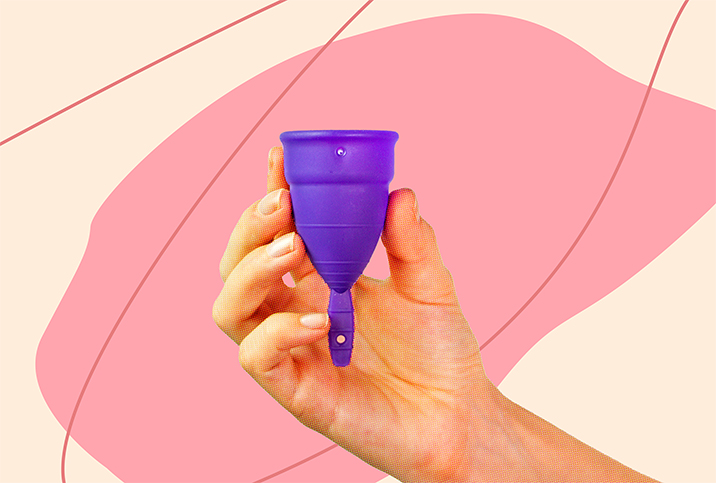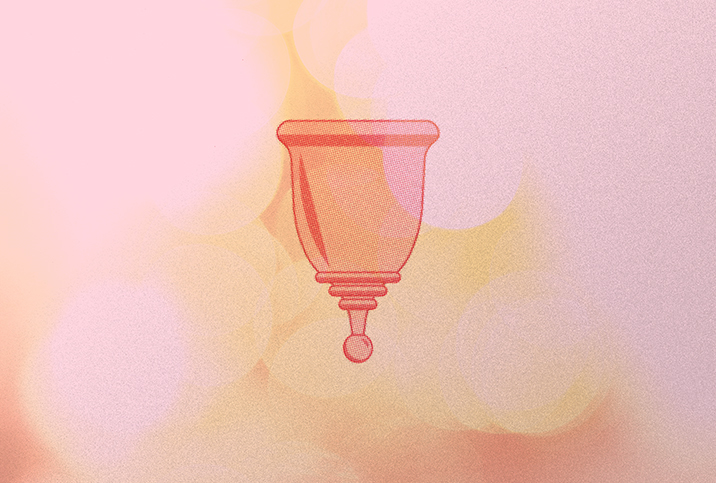Can You Use Your Menstrual Cup to Get Pregnant?

Trying for a baby can be an exciting, daunting and nerve-racking time. The thing is, with so much information available about infertility and secondary infertility (the inability to carry a child to term after a previously successful pregnancy), it's easy to start feeling nervous if you've been trying for a couple months unsuccessfully.
According to the Centers for Disease Control and Prevention (CDC), roughly 6 percent of married women meet the criteria for infertility—those who are unable to get pregnant after a year of trying, with 12 percent "having difficulty getting pregnant or carrying a pregnancy to term."
While most couples can and do end up welcoming a baby into their lives, it's natural to look for methods to increase success—however unconventional some of those methods may be. Some women are using their menstrual cups as a way to try to boost their chances of getting pregnant.
Granted, evidence of the validity of this method is anecdotal, rather than scientific, but even experts in the field admit there may be reasons to give it a try. Here's what you should know before buying a menstrual cup to use as a fertility-boosting tool.
The buzz about menstrual cups and pregnancy
Menstrual cups (as the name implies) have gained popularity as a way to manage and discard period blood during the menstrual cycle. The generally reusable cups are designed to be inserted into the vagina and placed at the cervical opening to catch the period tissue within a reservoir.
The reasons people enjoy using menstrual cups for menstruation (they're reusable and affordable, they prevent external flow of fluids, and they function as a safe, all-day solution) are the same reasons people are using them as a means to increase fertility. And the anecdotal evidence of menstrual cup pregnancy success stories is mounting.
Menstrual cup pregnancy success stories
Take, for instance, Heather Keita, a talent manager for an online cat-owner community, who used her menstrual cup in an attempt to boost her fertility after a year of unsuccessful trying. "We tried depositing the semen directly into the cup so it would stay in place. But we didn't think it did much except make things a little messier," Keita explained. That said, after a few months of trying, she ended up with a missed period, and when she took a pregnancy test, she had "a really nice dark line!" indicating she was pregnant.
'The cup basically acts as a barrier to sperm—it prevents it from leaving the vagina, directing it toward the cervix and the uterus.'
Of course, she can't claim the menstrual cup was the definitive key to her success. It could have just been that she and her husband finally timed everything right. "We don't know if we have the cup to credit or not, but with years of unprotected sex with a previous boyfriend, and a year of trying before I got pregnant, I never once had a pregnancy 'scare.' But a few months of wearing the cup seemed to do the job. I'm a bit of a skeptic, but maybe it worked?" Keita recounted.
Whether the cup did the trick or not, it's certainly the kind of story that makes a person want to give it a try.
How does using the menstrual cup to conceive work?
"The cup basically acts as a barrier to sperm—it prevents it from leaving the vagina, directing it toward the cervix and the uterus," said Marco Mouanness, M.D., an OB-GYN at Rejuvenating Fertility Center. "It also allows sperm to stay in contact with the cervix for a longer period of time, which increases your chances of conception."
"You only need one sperm to fertilize the egg, but the number of sperm that make it to the fallopian tube (where the egg is) is proportional to the number of sperm near the cervix," Mouanness added. "Keeping the sperm [near the cervix] for a longer period of time increases the likelihood that more sperm will make it to the egg, thereby (theoretically) increasing your chances of conception."
The logic behind using a menstrual cup to get pregnant seems strong. But no studies have been performed with menstrual cups to verify whether the anecdotal stories are based on simple luck and the placebo effect, or on actual science. That said, a few studies have been performed with cervical caps—a tool somewhat similar to a menstrual cup—with seemingly positive results.
Cervical cap vs. menstrual cup for fertility
The cervical cap, like the menstrual cup, is inserted into the vagina and placed at the opening of the cervix to block sperm from entering the uterus and fallopian tubes. It was invented as a form of birth control, although, when used alone, its pregnancy prevention rate isn't great—ranging from 68 to 84 percent. But, as with the menstrual cup, the logic holds that if it's designed to help prevent sperm from entering the cervix, it could be used to prevent sperm from exiting the cervix, too.
One study performed in 1997 found that using a cervical cap to keep sperm close to the cervix appeared to be a more successful artificial insemination method than using a straw to insert sperm close to the cervix. An older study, performed in 1983, found that couples experiencing primary infertility for at least a year experienced a 43 percent success rate of getting pregnant when using a cervical cap at home to perform artificial insemination.
That said, cervical caps are designed to sit closer to the cervix than most menstrual cups, whose reservoirs tend to be deeper. So, given that not much is known about why, how or even if the shape or location of such a tool may or may not impact fertilization, it's worth trying to mimic the cervical cap as much as possible since the few studies available have been with this tool.
As such, you should look for a shallower menstrual cup with more of a disc-like shape, rather than the longer, more cylindrical-shaped versions. There are several on the market, some disposable, and some designed for multiple uses. For instance, the Ziggy Cup, Flex Cup, Softdisc and Nixit all have a slightly more similar shape to the cervical cap.
Giving the menstrual cup a try for fertility
If you're wondering whether it's worth trying the menstrual cup to get pregnant, Mouanness said it's worth a shot. "Even if it doesn't help, it certainly doesn't cause any harm," he said. "You can either have your partner deposit sperm directly into the cup (either during intercourse using the pull-out method, or masturbation), or you can have sex (with your partner ejaculating inside), then insert the cup immediately while lying flat to ensure the sperm remains inside."
Either way, you can safely wear the inserted cup for 8 to 12 hours, which certainly could increase the likelihood that your partner's (or a donor's) sperm has the opportunity to get to where it needs to go.
Could it be the placebo effect? (Does it matter?)
For the anecdotes that indicate the menstrual cup method may, in fact, assist with pregnancy, the placebo effect could always be partly responsible. When people feel they're doing something that could help their chances of getting pregnant, their mood may improve, and their stress levels may decrease—which could have a positive impact on experiencing a successful pregnancy.
"There's evidence to suggest that improving mindset and feeling more optimistic can improve your fertility slightly," said Laura Spencer, a certified fertility coach who holds a master's in healthcare public policy.
"Infertility is very stressful. It puts an emotional strain on every area of life—mental health, physical health, and relationships," Spencer continued. "It can be very lonely and isolating."
As such, any tool or resource that can help during the pregnancy journey and provide the woman with a feeling of control over outcomes could help put her body and mind in the right space for pregnancy success.
Who shouldn't use a menstrual cup for pregnancy reasons
As with most things, not everyone is a candidate for using the menstrual cup method to get pregnant. "If you have a history of pelvic infection, sexually transmitted diseases, or you're likely to forget the menstrual cup in place, then it's probably not the method for you," Mouanness advised. "There are also no guidelines on how long the menstrual cup should be kept inside to increase your chances of pregnancy, but you shouldn't keep it in longer than 12 hours—the general guidelines for menstrual cup use."


















